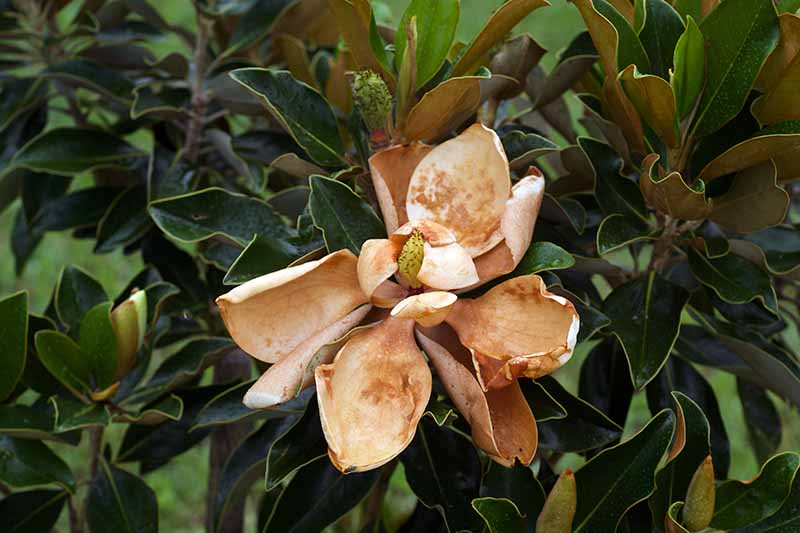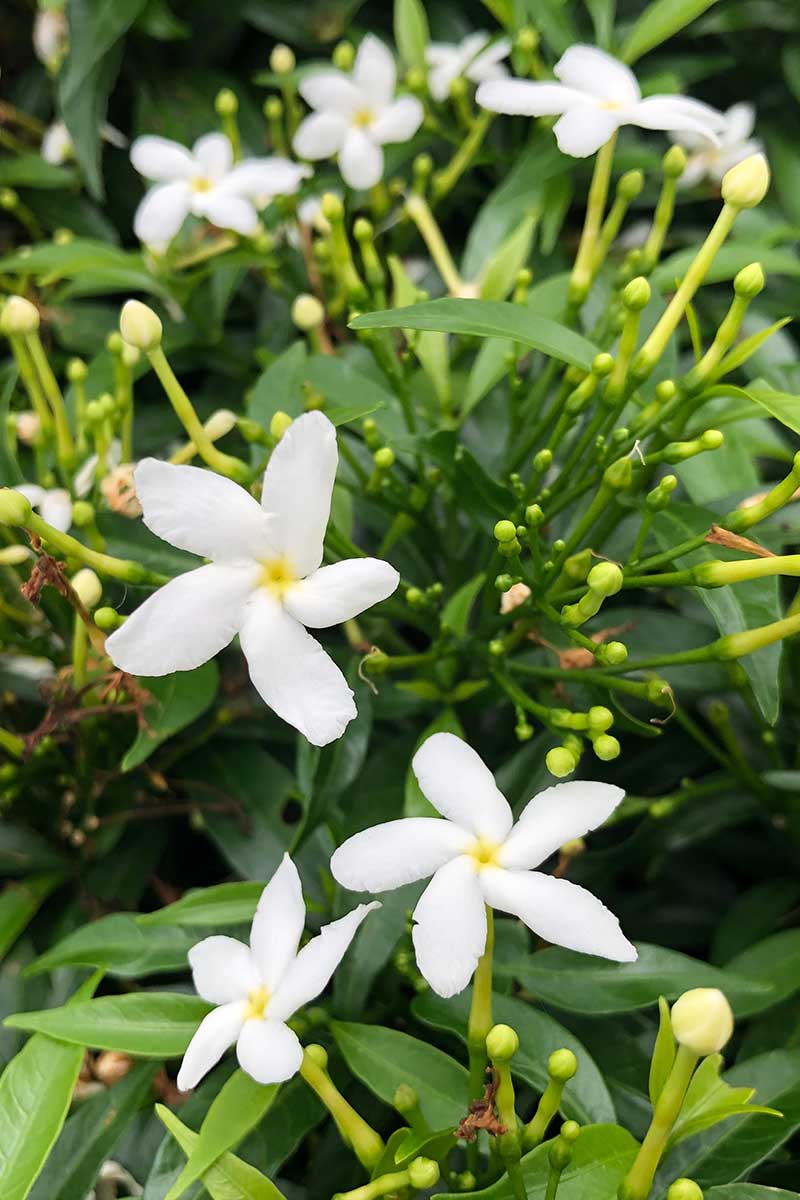Uh-oh. Does your outdoor gardenia have brittle branches and brown leaves following a bout of freezing temperatures?
Do you want to know if Gardenia jasminoides, an ornamental shrub, could recover from that damage? The clear answer is “Maybe.” ”.
We link to vendors to help you find relevant products. If you buy from one of our links, we may earn a commission.
We’ll talk more about why some gardenias might get hurt by frost, how to tell if your frost-damaged plant can recover, and how to keep your plants safe before it gets cold.
Gardenias are beautiful shrubs known for their fragrant, white blossoms that perfume the garden. However, these plants are not cold hardy and can suffer damage when the temperature dips below freezing. If your gardenias have been hit by a hard freeze, don’t give up on them yet! Proper pruning at the right time can help them recover and bloom again.
Assessing the Damage
After a freezing cold snap, inspect your gardenia bushes closely. Look for these signs of cold injury:
- Brittle, dry branches that break easily
- Brown or black leaves
- No new growth or buds
Light browning on just a few leaves is normal and the plant will recover. But significant dieback of stems and leaves indicates more serious damage.
Resist the temptation to cut back the damage right away. Pruning too soon could stress the plant further. Instead, wait until spring when you can better gauge how much of the shrub remains alive.
Spring Pruning for Recovery
Once spring arrives, check the branches more thoroughly. Look for new pale green shoots emerging from the base or lower portions of stems Also look for swelling leaf buds, which signal living tissue
If you don’t see signs of new growth by mid-spring your plant may have died back to the roots. In this case prune all the dead stems down to the ground. This severe pruning will remove any chance of blooms for the year but it will encourage the shrub to regrow from the base.
If you do see evidence of life on some branches, selectively prune back to the new growth. Leave any healthy stems intact. Cut dying branches back to the nearest living bud or green stem.
Make the pruning cuts clean and decisive with pruners sanitized between each cut. Avoid leaving stubs or ragged edges which can invite pests and disease.
Providing Aftercare
To help your frost damaged gardenia recover quickly
-
Apply a balanced fertilizer or acidic plant food in early spring. This gives the roots an extra boost.
-
Water deeply once a week if rainfall is lacking. Monitor soil moisture closely.
-
Mulch around the base with 2-3 inches of pine bark or other organic matter to retain moisture and acidity.
-
Shelter the shrub from hot afternoon sun which can further stress it. Consider a shade cloth.
-
Stop fertilizing by midsummer so new growth can harden off before fall.
-
In autumn, bring outdoor container plants into a protected area like a garage or porch overhang.
With proper aftercare following corrective pruning, many gardenias can make a full comeback after serious freeze damage. Pay close attention in the months after a harsh winter, and you may be rewarded with those beloved white blooms before season’s end.
Preventing Future Cold Injury
To avoid seeing your gardenias decline again, implement some winter protection strategies:
-
Water well before a hard freeze but avoid soggy soil which is more prone to freezing.
-
Cover plants with fabric row cover, burlap, or an old sheet if extreme cold is predicted.
-
For potted plants, temporarily move containers into a sheltered spot like a shed or indoors.
-
Choose cultivars rated for one zone colder than your gardening zone if available. ‘Kleim’s Hardy’ is a good option.
-
Stop fertilizing in late summer so growth hardens off before winter dormancy.
-
Prune judiciously in early fall to shape plants without stimulating excessive new growth.
-
Mulch heavily around the base going into winter.
-
Spray anti-transpirants to reduce moisture loss from leaves.
While gardenias dislike cold weather, proper care measures before, during, and after freezing conditions will help ensure their survival. Pay close attention around the first fall frost and be ready to take action at the first sign of damage. With quick response pruning in spring and attentive aftercare, your gardenia’s lovely flowers can grace your garden for years to come.
How to Assess and Prune Cold-Damaged Shrubs
It’s sad to see that the leaves and branches of your valuable evergreen are turning brown or black and crunchy, but it might not be the end of the world.
When it gets below 20°F, most gardenias will get some cold damage, and even the hardiest types might lose a few leaves to browning.
The good news is that if the plant hasn’t died all the way down to its roots, it might grow new leaves when the weather gets warmer again.

A plant that has mostly dead branches from being hit by snow or ice in the winter or early spring won’t bloom that year, even if it grows new shoots.
That’s because gardenias make buds in the fall for flowers the following year. If it freezes hard for a long time, both the buds and the branches will die.
When you’re trying to figure out if your cold-damaged shrub is dead, be patient. It may not send up new shoots for weeks, or until the middle of spring.
Don’t give up hope until midsummer.
The new growth will emerge from the base of the plant. When each shoot is five or six inches long, pinch the very end of it to speed things up and help the tree or shrub fill out.
You can prune away the dead portions, but wait until spring when temperatures are consistently above freezing. Cut back the branches before it gets really cold, because that will only make the plant more likely to get hurt by the cold.
When you prune, you can either cut the stems back to where you can see new growth, or you can cut the shrub in half at the base.
After that, feed the shrubs with acidic fertilizer or fish emulsion to encourage new growth. You can use any product you normally like.
You can now take a moment to mourn the loss of this year’s flowers or just be thankful that your plant made it through the freeze damage. And vow to do better at protecting your plants from cold damage, following the tips below.
Can Gardenias Survive Cold Damage?
I’ve lived in two Southern states, among many gardeners devoted to growing these fragrant shrubs outdoors.

But don’t let that regional affinity give you the wrong idea. All types of G. jasminoides are cold-hardy as far north as Zone 8, an area with 10 to 20°F average minimum temperatures.
A few newer hybrids can handle the colder winters in Zone 7, where the average low temperature is between 0°F and 10°F.
The daisy-bloom ‘Kleim’s Hardy,’ for example, is cold hardy in Zone 7. It is available from Home Depot in 2.5-gallon containers.
There are some hybrids that can even survive temperatures as low as -5°F to 0°F, which is what you’ll find in USDA Hardiness Zone 6b.
So, it’s not a given that a gardenia will succumb to the cold.
However, if your evergreen shrub has brown leaves and brittle stems after a long, hard freeze or an unexpected snowstorm, that is a sure sign that it has been damaged by the cold.
Will it live? That depends on how healthy the plant was before the freeze and how much damage it took. Keep reading for tips on assessing the damage.
Q&A – When can I cut back my gardenia bush?
FAQ
What month do you prune gardenias?
Should I cut my plants back after a freeze?
Can gardenias be cut back hard?
What to do with frost bitten gardenias?
When should I cut my gardenias back?
This is the point before new growth from the plant starts to emerge, and this is the right season for the plants to thrive after the cut, because the weather would be significant for this process. Homeowners can opt to cut their gardenias back during fall; however, the plant should no longer be producing leaves or flowers at this time.
Can gardenias die in winter?
Plants that are exposed and have no other shielding plants or buildings are susceptible to cold injury of gardenias. Whatever you do, don’t start hacking off the dead growth in winter. This can cause more harm than good and it isn’t apparent the tissue is fully dead at this time.
How do you protect a gardenia in cold weather?
Mulches are effective in protecting a gardenia in cold weather but should be pulled away from the base in spring. Plants that are exposed and have no other shielding plants or buildings are susceptible to cold injury of gardenias. Whatever you do, don’t start hacking off the dead growth in winter.
How to cut back a gardenia Bush?
Now, you can cut them back to a height that will give your gardenia bush an excellent shape and size. Ensure that each cut is also at a 45-degree angle. Do the same thing for branches that are growing in the wrong direction.
- The Ultimate Guide to Growing Strawberries in Raised Beds - August 8, 2025
- No-Dig Garden Beds: The Easiest Way to Grow a Beautiful Garden - August 6, 2025
- How to Protect and Preserve Wood for Raised Garden Beds - August 6, 2025

